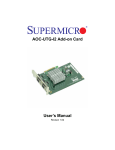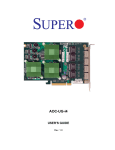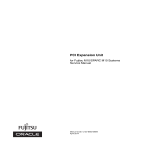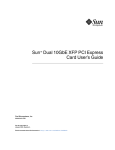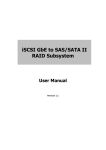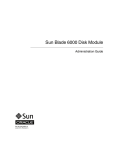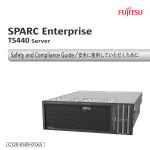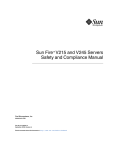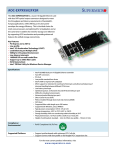Download Sun Microsystems 5945532 User's Manual
Transcript
Sun™ Dual 10GbE SFP+ PCIe ExpressModule User’s Guide Sun Microsystems, Inc. www.sun.com Part No. 820-4979-10 August 2008, Revision A Submit comments about this document at: http://www.sun.com/hwdocs/feedback Copyright © 2008 Sun Microsystems, Inc., 4150 Network Circle, Santa Clara, California 95054, U.S.A. All rights reserved. This distribution may include materials developed by third parties. Sun, Sun Microsystems, the Sun logo, SunSolve, Sun Fire, and Solaris are trademarks or registered trademarks of Sun Microsystems, Inc., or its subsidiaries, in the U.S. and other countries. UNIX is a registered trademark in the U.S. and other countries, exclusively licensed through X/Open Company, Ltd. Intel is a trademark or registered trademark of Intel Corporation or its subsidiaries in the United States and other countries. Intel Xeon is a trademark or registered trademark of Intel Corporation or its subsidiaries in the United States and other countries. The Adobe logo is a registered trademark of Adobe Systems, Incorporated. Use of any spare or replacement CPUs is limited to repair or one-for-one replacement of CPUs in products exported in compliance with U.S. export laws. Use of CPUs as product upgrades unless authorized by the U.S. Government is strictly prohibited. DOCUMENTATION IS PROVIDED "AS IS" AND ALL EXPRESS OR IMPLIED CONDITIONS, REPRESENTATIONS AND WARRANTIES, INCLUDING ANY IMPLIED WARRANTY OF MERCHANTABILITY, FITNESS FOR A PARTICULAR PURPOSE OR NON-INFRINGEMENT, ARE DISCLAIMED, EXCEPT TO THE EXTENT THAT SUCH DISCLAIMERS ARE HELD TO BE LEGALLY INVALID. Copyright © 2008 Sun Microsystems, Inc., 4150 Network Circle, Santa Clara, California 95054, Etats-Unis. Tous droits réservés. Cette distribution peut comprendre des composants développés par des tierces parties. Sun, Sun Microsystems, le logo Sun, SunSolve, Sun Fire, et Solaris sont des marques de fabrique ou des marques déposées de Sun Microsystems, Inc., ou ses filiales, aux Etats-Unis et dans d’autres pays. UNIX est une marque déposée aux Etats-Unis et dans d’autres pays et licenciée exlusivement par X/Open Company, Ltd. Intel est une marque de fabrique ou une marque déposée de Intel Corporation ou de sa filiale aux Etats-Unis et dans d’autres pays. Intel Xeon est une marque de fabrique ou une marque déposée de Intel Corporation ou de sa filiale aux Etats-Unis et dans d’autres pays. Le logo Adobe est une marque déposée de Adobe Systems, Incorporated. L’utilisation de pieces detachees ou d’unites centrales de remplacement est limitee aux reparations ou a l’echange standard d’unites centrales pour les produits exportes, conformement a la legislation americaine en matiere d’exportation. Sauf autorisation par les autorites des EtatsUnis, l’utilisation d’unites centrales pour proceder a des mises a jour de produits est rigoureusement interdite. LA DOCUMENTATION EST FOURNIE "EN L’ETAT" ET TOUTES AUTRES CONDITIONS, DECLARATIONS ET GARANTIES EXPRESSES OU TACITES SONT FORMELLEMENT EXCLUES, DANS LA MESURE AUTORISEE PAR LA LOI APPLICABLE, Y COMPRIS NOTAMMENT TOUTE GARANTIE IMPLICITE RELATIVE A LA QUALITE MARCHANDE, A L’APTITUDE A UNE UTILISATION PARTICULIERE OU A L’ABSENCE DE CONTREFACON. Contents Preface 1. xv Sun Dual 10GbE SFP+ PCIe ExpressModule Overview Shipping Kit Contents 1 ExpressModule Hardware Overview ExpressModule Features 1 2 Indicator Lights on the ExpressModule Hardware and Software Requirements Patch Requirements Patches and Updates 2. 1 3 5 5 6 Installing and Setting Up the Device Driver Software 7 Downloading and Installing the Driver on a Linux Platform ▼ To Download the Driver for a Linux Platform ▼ To Install the Driver for a Linux Platform ▼ To Remove the Driver From a Linux Platform 7 7 8 9 Downloading and Installing the Driver on a Microsoft Windows Platform 3. 10 ▼ To Download and Install the Driver on a Microsoft Windows Platform ▼ To Remove the Driver From a Microsoft Windows Platform Installing the ExpressModule 10 11 13 iii Installing an Optical Transceiver ▼ To Install an Optical Transceiver Installing the ExpressModule ▼ 13 16 To Install the ExpressModule With the Power Off Verifying the Installation 4. 13 16 19 ▼ To Verify the Installation in a Linux System ▼ To Verify the Installation in a Microsoft Windows System Network Configuration 19 19 21 Configuring the Network Host Files for Booting Over the Gigabit Ethernet Network for Linux Systems 21 ▼ 5. To Boot Over the Network on Linux Systems Configuring the Driver Parameters Driver Overview 23 23 Driver Parameters for Linux Systems 24 Setting ixgbe Driver Parameters in Linux Systems ▼ 6. To Configure Jumbo Frames Configuring VLANs VLAN Overview 25 27 30 ▼ To Configure VLANs in a Linux Environment ▼ To Configure VLANs in a Microsoft Windows 2003 Environment Configuring Bonding for Multiple Interfaces 30 32 ▼ To Configure Bonding for Multiple ixgbe Interfaces ▼ To Remove Bonding 36 Technical Features 32 33 Sun Dual 10GbE SFP+ PCIe ExpressModule Specifications Connectors iv 25 27 Configuring VLANs A. 21 37 Sun Dual 10GbE SFP+ PCIe ExpressModule User’s Guide • August 2008 35 31 Physical Characteristics 37 Power and Environmental Requirements Index 38 39 Contents v vi Sun Dual 10GbE SFP+ PCIe ExpressModule User’s Guide • August 2008 Regulatory Compliance Statements Your Sun product is marked to indicate its compliance class: • Federal Communications Commission (FCC) — USA • Industry Canada Equipment Standard for Digital Equipment (ICES-003) — Canada • Voluntary Control Council for Interference (VCCI) — Japan • Bureau of Standards Metrology and Inspection (BSMI) — Taiwan Please read the appropriate section that corresponds to the marking on your Sun product before attempting to install the product. FCC Class A Notice This device complies with Part 15 of the FCC Rules. Operation is subject to the following two conditions: 1. This device may not cause harmful interference. 2. This device must accept any interference received, including interference that may cause undesired operation. Note: This equipment has been tested and found to comply with the limits for a Class A digital device, pursuant to Part 15 of the FCC Rules. These limits are designed to provide reasonable protection against harmful interference when the equipment is operated in a commercial environment. This equipment generates, uses, and can radiate radio frequency energy, and if it is not installed and used in accordance with the instruction manual, it may cause harmful interference to radio communications. Operation of this equipment in a residential area is likely to cause harmful interference, in which case the user will be required to correct the interference at his own expense. Modifications: Any modifications made to this device that are not approved by Sun Microsystems, Inc. may void the authority granted to the user by the FCC to operate this equipment. ICES-003 Class A Notice - Avis NMB-003, Classe A This Class A digital apparatus complies with Canadian ICES-003. Cet appareil numérique de la classe A est conforme à la norme NMB-003 du Canada. vii BSMI Class A Notice The following statement is applicable to products shipped to Taiwan and marked as Class A on the product compliance label. T33012 CCC Class A Notice The following statement is applicable to products shipped to China and marked with “Class A” on the product’s compliance label. GOST-R Certification Mark viii Sun Dual 10GbE SFP+ PCIe ExpressModule User’s Guide • August 2008 Safety Agency Compliance Statements Read this section before beginning any procedure. The following text provides safety precautions to follow when installing a Sun Microsystems product. Depending on the type of power switch your device has, one of the following symbols may be used: On – Applies AC power to the system. Off – Removes AC power from the system. Safety Precautions For your protection, observe the following safety precautions when setting up your equipment: ■ Follow all cautions and instructions marked on the equipment. ■ Ensure that the voltage and frequency of your power source match the voltage and frequency inscribed on the equipment’s electrical rating label. ■ Never push objects of any kind through openings in the equipment. Dangerous voltages may be present. Conductive foreign objects could produce a short circuit that could cause fire, electric shock, or damage to your equipment. Symbols The following symbols may appear in this book: Caution – There is a risk of personal injury and equipment damage. Follow the instructions. Standby – The On/Standby switch is in the standby position. Modifications to Equipment Do not make mechanical or electrical modifications to the equipment. Sun Microsystems is not responsible for regulatory compliance of a modified Sun product. Placement of a Sun Product Caution – Do not block or cover the openings of your Sun product. Never place a Sun product near a radiator or heat register. Failure to follow these guidelines can cause overheating and affect the reliability of your Sun product. System Unit Cover Caution – Hot surface. Avoid contact. Surfaces are hot and may cause personal injury if touched. Caution – Hazardous voltages are present. To reduce the risk of electric shock and danger to personal health, follow the instructions. You must remove the cover of your Sun computer system unit to add cards, memory, or internal storage devices. Be sure to replace the cover before powering on your computer system. Caution – Do not operate Sun products without the cover in place. Failure to take this precaution may result in personal injury and system damage. ix Conformité aux normes de sécurité Veuillez lire attentivement cette section avant de commencer. Ce texte traite des mesures de sécurité qu’il convient de prendre pour l’installation d’un produit Sun Microsystems. Mesures de sécurité Pour votre sécurité, nous vous recommandons de suivre scrupuleusement les mesures de sécurité ci-dessous lorsque vous installez votre matériel: ■ Suivez tous les avertissements et toutes les instructions inscrites sur le matériel. ■ Assurez-vous que la tension et la fréquence de votre source d'alimentation correspondent à la tension et à la fréquence indiquées sur l'étiquette de la tension électrique nominale du matériel ■ N'introduisez jamais d'objets quels qu'ils soient dans les ouvertures de l'équipement. Vous pourriez vous trouver en présence de hautes tensions dangereuses. Tout objet étranger conducteur risque de produire un court-circuit pouvant présenter un risque d'incendie ou de décharge électrique, ou susceptible d'endommager le matériel. Symboles Vous trouverez ci-dessous la signification des différents symboles utilisés: Marche – Met le système sous tension alternative. Arret – Met le système hors tension alternative. Veilleuse – L'interrupteur Marche/Veille est sur la position de veille. Modification du matériel N'apportez aucune modification mécanique ou électrique au matériel. Sun Microsystems décline toute responsabilité quant à la non-conformité éventuelle d'un produit Sun modifié. Positionnement d’un produit Sun Attention – Evitez d'obstruer ou de recouvrir les orifices de votre produit Sun. N'installez jamais un produit Sun près d'un radiateur ou d'une source de chaleur. Si vous ne respectez pas ces consignes, votre produit Sun risque de surchauffer et son fonctionnement en sera altéré. Attention – Vous risquez d'endommager le matériel ou de vous blesser. Veuillez suivre les instructions. Attention – Surfaces brûlantes. Evitez tout contact. Les surfaces sont brûlantes. Vous risquez de vous blesser si vous les touchez. Couvercle de l'unité Pour ajouter des cartes, de la mémoire ou des périphériques de stockage internes, vous devez retirer le couvercle de votre système Sun. Remettez le couvercle supérieur en place avant de mettre votre système sous tension. Attention – Ne mettez jamais des produits Attention – Tensions dangereuses. Pour réduire les risques de décharge électrique et de danger physique, observez les consignes indiquées. Sun sous tension si leur couvercle supérieur n'est pas mis en place. Si vous ne prenez pas ces précautions, vous risquez de vous blesser ou d'endommager le système. Selon le type d'interrupteur marche/arrêt dont votre appareil est équipé, l'un des symboles suivants sera utilisé: x Sun Dual 10GbE SFP+ PCIe ExpressModule User’s Guide • August 2008 Einhaltung sicherheitsbehördlicher Vorschriften Lesen Sie vor dem Ausführen von Arbeiten diesen Abschnitt. Im folgenden Text werden Sicherheitsvorkehrungen beschrieben, die Sie bei der Installation eines Sun Microsystems-Produkts beachten müssen. Aus– Unterbricht die Wechselstromzufuhr zum Gerät. Wartezustand – Der Ein-/Standby-Netzschalter befindet sich in der Standby-Position. Sicherheitsvorkehrungen Treffen Sie zu Ihrem eigenen Schutz bei der Installation des Geräts die folgenden Sicherheitsvorkehrungen: ■ Beachten Sie alle auf den Geräten angebrachten Warnhinweise und Anweisungen. ■ Stellen Sie sicher, dass Spannung und Frequenz der Stromversorgung den Nennleistungen auf dem am Gerät angebrachten Etikett entsprechen. ■ Führen Sie niemals Fremdobjekte in die Öffnungen am Gerät ein. Es können gefährliche Spannungen anliegen. Leitfähige Fremdobjekte können einen Kurzschluss verursachen, der einen Brand, Stromschlag oder Geräteschaden herbeiführen kann. Modifikationen des Geräts Nehmen Sie keine elektrischen oder mechanischen Gerätemodifikationen vor. Sun Microsystems ist für die Einhaltung der Sicherheitsvorschriften von modifizierten Sun-Produkten nicht haftbar. Gehäuseabdeckung Sie müssen die Abdeckung Ihres Sun-Computersystems entfernen, um Karten, Speicher oder interne Speichergeräte hinzuzufügen. Bringen Sie vor dem Einschalten des Systems die Gehäuseabdeckung wieder an. Symbole Achtung – Nehmen Sie Sun-Geräte nicht Die Symbole in diesem Handbuch haben folgende Bedeutung: ohne Abdeckung in Betrieb. Die Nichtbeachtung dieses Warnhinweises kann Verletzungen oder Geräteschaden zur Folge haben. Achtung – Gefahr von Verletzung und Geräteschaden. Befolgen Sie die Anweisungen. Achtung – Heiße Oberfläche. Nicht berühren, da Verletzungsgefahr durch heiße Oberfläche besteht. Achtung – Gefährliche Spannungen. Befolgen Sie die Anweisungen, um Stromschläge und Verletzungen zu vermeiden. Je nach Netzschaltertyp an Ihrem Gerät kann eines der folgenden Symbole verwendet werden: Ein – Versorgt das System mit Wechselstrom. Safety Agency Compliance Statements xi Normativas de seguridad Lea esta sección antes de realizar cualquier operación. En ella se explican las medidas de seguridad que debe tomar al instalar un producto de Sun Microsystems. Medidas de seguridad Apagado – Corta la alimentación de CA del sistema. Espera – El interruptor de encendido/espera está en la posición de espera. Para su protección, tome las medidas de seguridad siguientes durante la instalación del equipo: ■ Siga todos los avisos e instrucciones indicados en el equipo. ■ Asegúrese de que el voltaje y frecuencia de la fuente de alimentación coincidan con el voltaje y frecuencia indicados en la etiqueta de clasificación eléctrica del equipo. ■ No introduzca objetos de ningún tipo por las rejillas del equipo, ya que puede quedar expuesto a voltajes peligrosos. Los objetos conductores extraños pueden producir cortocircuitos y, en consecuencia, incendios, descargas eléctricas o daños en el equipo. Símbolos En este documento aparecen los siguientes símbolos: Modificaciones en el equipo No realice modificaciones de tipo mecánico ni eléctrico en el equipo. Sun Microsystems no se hace responsable del cumplimiento de normativas en caso de que un producto Sun se haya modificado. Colocación de un producto Sun Precaución – No obstruya ni tape las rejillas del producto Sun. Nunca coloque un producto Sun cerca de radiadores ni fuentes de calor. Si no sigue estas indicaciones, el producto Sun podría sobrecalentarse y la fiabilidad de su funcionamiento se vería afectada. Precaución – Existe el riesgo de que se produzcan lesiones personales y daños en el equipo. Siga las instrucciones. Precaución – Superficie caliente. Evite todo contacto. Las superficies están calientes y pueden causar lesiones personales si se tocan. Precaución – Voltaje peligroso. Para reducir el riesgo de descargas eléctricas y lesiones personales, siga las instrucciones. En función del tipo de interruptor de alimentación del que disponga el dispositivo, se utilizará uno de los símbolos siguientes: Encendido – Suministra alimentación de CA al sistema. xii Sun Dual 10GbE SFP+ PCIe ExpressModule User’s Guide • August 2008 Declaration of Conformity Compliance Model Number: Product Family Name: 5945532 Sun Dual 10GbE SFP+ PCIe ExpressModule EMC USA—FCC Class A This equipment complies with Part 15 of the FCC Rules. Operation is subject to the following two conditions: 1. This equipment may not cause harmful interference. 2. This equipment must accept any interference that may cause undesired operation. Canada This Class A digital apparatus complies with Canadian ICES-003. European Union This equipment complies with the following requirements of the EMC Directive 2004/108/EC: As Information Technology Equipment (ITE) Class A per (as applicable): EN 55022:2006 Class A EN 61000-3-2:2000 +A2:2005 Pass EN 61000-3-3:1995 +A1:2001 Pass EN 55024:1998 +A1:2001 +A2:2003 Required Limits: IEC61000-4-2 4 kV (Direct), 8 kV (Air) IEC61000-4-3 3 V/m IEC61000-4-4 1 kV AC Power Lines, 0.5 kV Signal and DC Power Lines IEC61000-4-5 1 kV AC Line-Line and Outdoor Signal Lines, 2 kV AC Line-Gnd, 0.5 kV DC Power Lines IEC61000-4-6 3V IEC61000-4-8 1 A/m IEC61000-4-11 Pass Safety This equipment complies with the following requirements of the Low Voltage Directive2006/95/EC: EC Type Examination Certificates: EN 60950-1:2001, 1st Edition IEC 60950-1:2001, 1st Edition Evaluated to all CB Countries UL 60950-1:2003, CSA C22.2 No. 60950-03 CB Scheme Certificate No. NO47596 File: E139761 Vol. 7 Supplementary Information This equipment was tested and complies with all the requirements for the CE Mark. This equipment complies with the Restriction of Hazardous Substances (RoHS) directive 2002/95/EC. . /S/ Dennis P. Symanski Worldwide Compliance Office Sun Microsystems, Inc. 4150 Network Circle, MPK15-102 Santa Clara, CA 95054 U.S.A. Tel: 650-786-3255 Fax: 650-786-3723 DATE xiii xiv Sun Dual 10GbE SFP+ PCIe ExpressModule User’s Guide • August 2008 Preface This user’s guide provides hardware and software installation instructions for the Sun™ Dual 10GbE SFP+ PCIe Express Module. This document also describes how to configure the driver software for the ixgbe driver for Linux operating systems and Microsoft Windows Server 2003. These instructions are designed for enterprise system administrators with experience installing network hardware and software. Note – In this document the term x86 refers to 64-bit and 32-bit systems manufactured using processors compatible with the AMD64, Intel® Xeon®, or Intel Pentium product families. How This Document Is Organized Chapter 1 describes the Sun 10GbE XFP SR PCI Express Card hardware and software. Chapter 2 explains how to download, install, and verify the ixgbe device driver software on Linux and Microsoft Windows systems. Chapter 3 describes how to install the Ethernet adapter in your system and verify that it has been installed correctly. Chapter 4 describes how to edit the network host files after the Ethernet adapter has been installed on your system. Chapter 5 describes how to configure the ixgbe driver parameters. xv Chapter 6 explains virtual local area networks (VLANs), and provides configuration instructions and examples. Appendix A lists the specifications for the Sun 10GbE XFP SR PCI Express Card. Typographic Conventions Typeface* Meaning Examples AaBbCc123 The names of commands, files, and directories; on-screen computer output Edit your.login file. Use ls -a to list all files. % You have mail. AaBbCc123 What you type, when contrasted with on-screen computer output % su Password: AaBbCc123 Book titles, new words or terms, words to be emphasized. Replace command-line variables with real names or values. Read Chapter 6 in the User’s Guide. These are called class options. You must be superuser to do this. To delete a file, type rm filename. * The settings on your browser might differ from these settings. Shell Prompts Shell Prompt C shell machine-name% C shell superuser machine-name# Bourne shell and Korn shell $ Bourne shell and Korn shell superuser # xvi Sun Dual 10GbE SFP+ PCIe ExpressModule User’s Guide • August 2008 Related Documentation The documents listed as online are available at: http://docs.sun.com/app/docs/prod/dual.sfp.pcie Application Title Part Number Format Location Release Notes Sun 10GbE XFP SR PCI Express Card, Sun Dual 10GbE XFP 2 SR PCI Express Card, and Sun Dual 10GbE SFP+ PCIe ExpressModule Release Notes 820-4505 PDF HTML Online Getting Started Sun Dual 10GbE SFP+ PCIe ExpressModule Getting 820-4981 Started Guide Hardcopy Ship kit Safety and compliance Safety and Compliance Manual Hardcopy Ship kit 816-7190 Documentation, Support, and Training Sun Function URL Documentation http://www.sun.com/documentation/ Support http://www.sun.com/support/ Training http://www.sun.com/training/ Third-Party Web Sites Sun is not responsible for the availability of third-party web sites mentioned in this document. Sun does not endorse and is not responsible or liable for any content, advertising, products, or other materials that are available on or through such sites or resources. Sun will not be responsible or liable for any actual or alleged damage or loss caused by or in connection with the use of or reliance on any such content, goods, or services that are available on or through such sites or resources. Preface xvii Sun Welcomes Your Comments Sun is interested in improving its documentation and welcomes your comments and suggestions. You can submit your comments by going to: http://www.sun.com/hwdocs/feedback Please include the title and part number of your document with your feedback: Sun Dual 10GbE SFP+ PCIe ExpressModule User’s Guide, part number 820-4979-10 xviii Sun Dual 10GbE SFP+ PCIe ExpressModule User’s Guide • August 2008 CHAPTER 1 Sun Dual 10GbE SFP+ PCIe ExpressModule Overview This chapter describes the Sun 10GbE XFP SR PCI Express Card hardware and software, and includes the following sections: ■ “Shipping Kit Contents” on page 1 ■ “ExpressModule Hardware Overview” on page 1 ■ “Hardware and Software Requirements” on page 5 ■ “Patch Requirements” on page 5 ■ “Patches and Updates” on page 6 Shipping Kit Contents The carton in which your Sun 10GbE XFP SR PCI Express Card was shipped should contain the following items: ■ Sun 10GbE XFP SR PCI Express Card ■ Sun Dual 10GbE SFP+ PCIe ExpressModule Getting Started Guide ■ Safety and Compliance Manual ExpressModule Hardware Overview The Sun 10GbE XFP SR PCI Express Card is a 10 Gigabit Ethernet (10GbE) fiber network interface card (NIC) for PCI Express systems. The ExpressModule is based on the dual-port Intel 82598EB 10GbE controller. 1 The ExpressModule is optimized for Intel I/O Acceleration Technology (I/OAT), which is designed to optimize network I/O. The ExpressModule is a highperformance, highly integrated 10 Gigabit Ethernet LAN card with PCIe host interface and fiber LAN connectors on the optical modules. The product conforms to the IEEE 802.3 standard and supports standards for system manageability and power management. FIGURE 1-1 Sun Dual 10GbE SFP+ PCIe ExpressModule ExpressModule Features The Sun 10GbE XFP SR PCI Express Card provides the following features and benefits: 2 ■ Intel 82598EB 10 Gigabit Ethernet controller ■ Load balancing on multiple CPUs ■ Intel I/O Acceleration Technology (I/OAT) ■ iSCSI remote boot support ■ MSI-X support ■ Virtual Machine Device queues (VMDq) ■ Low latency ■ Optimized queues – 32 transmit (Tx) and 64 receive (Rx) per port Sun Dual 10GbE SFP+ PCIe ExpressModule User’s Guide • August 2008 ■ Compatible with x8 standard and low-profile PCI Express slots ■ Support for most network operating systems (NOS) ■ Remote management support ■ Support for SFP+ form factor transceivers ■ RoHS compliant, lead-free technology ■ Intel PROSet Utility for Windows Device Manager Indicator Lights on the ExpressModule On the front panel of the ExpressModule (shown in FIGURE 1-2) next to each port, there are viewing holes for two lights dedicated to that port. FIGURE 1-2 Front Panel Lights and Attention Switch TABLE 1-1 explains the meaning of the lights for each port. Chapter 1 Sun Dual 10GbE SFP+ PCIe ExpressModule Overview 3 TABLE 1-1 Indicator Lights for Each Port on the ExpressModule Label Color Meaning ACT/LINK Green Activity 10G/1G Green 10GbE link 10G/1G Amber 1GbE link Two LEDs are on the ExpressModule next to the Attention switch. One LED emits green light, the LED other emits amber light. Each light can be on, off, or blinking. TABLE 1-2 explains the meaning of these lights. TABLE 1-2 LED Indicator Lights on the ExpressModule LED Color LED State Meaning Action Green Off Power off Insertion or removal of add-in cards is permitted. All supply voltages (except Vaux) have been removed from the slot if required for add-in card removal. Green On Power on The slot is powered on. Insertion or removal of add-in cards is not permitted. Green Blinking Power transition The slot is in the process of powering up or down. Insertion of removal of add-in cards is not permitted. Amber Off Normal Operation is normal. Amber On Attention There is an operation problem at this slot. Amber Blinking Locate This slot is being identified at user request. Note – The Attention switch currently is not supported. 4 Sun Dual 10GbE SFP+ PCIe ExpressModule User’s Guide • August 2008 Hardware and Software Requirements Before using the Sun 10GbE XFP SR PCI Express Card, ensure that your system meets the hardware and software requirements in TABLE 1-3. TABLE 1-3 Hardware and Software Requirements Requirements Supported Products Hardware Sun Sun Sun Sun Operating system Red Hat Enterprise Linux 5.1 (32-bit Red Hat Enterprise Linux 4.6 (32-bit SUSE 10-Sp1 (64-bit) Microsoft Windows 2008 (32-bit and Microsoft Windows 2003 (32-bit and Blade Blade Blade Blade X6220 X6250 X6450 X8420 Server Server Server Server Module Module Module* Module and 64-bit) and 64-bit) 64-bit) 64-bit) * Sun Blade X6450 Server Module supports Linux only. Note – The preceding information is up-to-date at the time this manual was written. Go to http://www.sun.com/ for the latest information. Subsequent versions of this document have a higher number following the final dash. That is, 820-4979-10, becomes 820-4979-11. Patch Requirements You must install the latest version of the patch from the following web site: http://sunsolve.sun.com If the patch is not available on the SunSolveSM web site, contact your local sales or service representative. Chapter 1 Sun Dual 10GbE SFP+ PCIe ExpressModule Overview 5 Patches and Updates Check the Sun Update Connection to ensure that you have the latest recommended patch clusters and security patches. You can download the latest recommended patch clusters and security patches at: http://sunsolve.sun.com/pub-cgi/show.pl?target=patchpage 6 Sun Dual 10GbE SFP+ PCIe ExpressModule User’s Guide • August 2008 CHAPTER 2 Installing and Setting Up the Device Driver Software This chapter explains how to install and remove the ixgbe driver on Linux and Microsoft Windows systems. This chapter contains the following sections: ■ “Downloading and Installing the Driver on a Linux Platform” on page 7 ■ “Downloading and Installing the Driver on a Microsoft Windows Platform” on page 10 Downloading and Installing the Driver on a Linux Platform If your system uses the RedHat or SuSe Linux operating system, you must download the ixgbe device driver to install it. ▼ To Download the Driver for a Linux Platform 1. Log in to your system. 2. With a browser, go to this location: http://support.intel.com/support/network/adapter/10gbe/srdualserverxpr/ 3. Select the following product: Intel® 10 Gigabit XF SR Dual Port ExpressModule 7 4. Select this option: Download drivers and software 5. Select Linux as the operating system. 6. Locate the following driver and select Download: Network Adapter Driver for 10 GbE PCI-E Based Network Connections for Linux 7. Review and accept the software license agreement. 8. Select this option: Download Network Adapter Driver for 10 GbE PCI-E Based Network Connections for Linux The download begins. The file named ixgbe-1.3.16.1.tar.gz is saved in the ~/Desktop directory of your system. ▼ To Install the Driver for a Linux Platform 1. Copy the file containing the driver from ~/Desktop to /temp. The file is named ixgbe-1.3.16.1.tar.gz. 2. Uncompress and untar the file with this command: # tar -zxvf ixgbe-1.3.16.1.tar.gz 3. Go to the newly created src directory: # cd /temp/ixgbe-1.3.16.1/src 4. Compile the driver source file with these commands: # make # make install 5. Load the ixgbe driver with the modprobe command: # modprobe ixgbe 8 Sun Dual 10GbE SFP+ PCIe ExpressModule User’s Guide • August 2008 6. Verify that the ixgbe driver has been successfully installed with this lsmod command: # lsmod | grep ixgbe The output should be similar to the following: ixgbe 118052 0 7. Check the ixgbe driver version with this modinfo command: # modinfo ixgbe | grep ver For example, the output might be the following: filename: version: description: srcversion: vermagic: ▼ /lib/modules/2.6.18-53.el5/kernel/drivers/net/ixgbe/ixgbe.ko 1.3.16.1-lro Intel(R) 10 Gigabit PCI Express Network Driver 5CFF6AEBA251050F8A4B746 2.6.18-53.el5 SMP mod_unload gcc-4.1 To Remove the Driver From a Linux Platform ● Use the rmmod command: # rmmod ixgbe Chapter 2 Installing and Setting Up the Device Driver Software 9 Downloading and Installing the Driver on a Microsoft Windows Platform If your system uses the Microsoft Windows Server 2003 operating system, perform the following procedures to download and install the device driver. ▼ To Download and Install the Driver on a Microsoft Windows Platform 1. Log in to your system. 2. With a browser, go to this location: http://support.intel.com/support/network/adapter/10gbe/srdualserverxpr/ 3. Select the following product: Intel® 10 Gigabit XF SR Dual Port ExpressModule 4. Select this option: Download drivers and software 5. Select one of the following as the operating system: ■ For a 64-bit driver: Windows Server 2003 Standard x64 Edition ■ For a 32-bit driver: Windows Server 2003 Standard Edition 6. Locate one of the following and select Download next to it: ■ For a 64-bit driver: Network Adapter Driver for Windows XP Professional x64 Edition or Windows Server 2003 x64 Edition ■ For a 32-bit driver: Network Adapter Drivers for Windows 2000, Windows XP, and Windows Server 2003 7. Review and accept the software license agreement. 8. Select one of the following to start the download: ■ Download Network Adapter Driver for Windows XP Professional x64 Edition or Windows Server 2003 x64 Edition ■ Download Network Adapter Drivers for Windows 2000, Windows XP, and Windows Server 2003 The download begins. 10 Sun Dual 10GbE SFP+ PCIe ExpressModule User’s Guide • August 2008 9. Click on the following exe files to install the driver: ■ For a 64-bit driver: PROEM64T.exe ■ For a 32-bit driver: PRO2KXP.exe 10. Follow the instructions in the installation wizard. 11. If the Found New Hardware Wizard screen is displayed, click Cancel. The autorun automatically runs after you have extracted the files. ▼ To Remove the Driver From a Microsoft Windows Platform 1. From the Control Panel, double-click Add/Remove Programs. 2. Select Intel PRO Network Connections Drivers. 3. Click Add/Remove. 4. When the confirmation dialog displays, click OK. Chapter 2 Installing and Setting Up the Device Driver Software 11 12 Sun Dual 10GbE SFP+ PCIe ExpressModule User’s Guide • August 2008 CHAPTER 3 Installing the ExpressModule This chapter describes how to install the ExpressModule in your system and verify that it is recognized by the operating system. This chapter contains the following sections: ■ “Installing an Optical Transceiver” on page 13 ■ “Installing the ExpressModule” on page 16 ■ “Verifying the Installation” on page 19 Installing an Optical Transceiver The Sun 10GbE XFP SR PCI Express Card requires a short-range optical transceiver in at least one port to create an Ethernet connection. The short-range optical transceiver (part number X5561A-Z) is available from Sun Microsystems. Note – Install the optical transceivers into the ExpressModule before installing the ExpressModule into the system. ▼ To Install an Optical Transceiver 1. Pull the locking handle into the full horizontal position. You will feel the handle click into position when it is fully opened. 13 2. Holding the optical transceiver by the edges, align the transceiver with the slot in the ExpressModule and slide the transceiver into the opening. 3. Applying even pressure at both corners of the transceiver, push the transceiver until it is firmly seated in the slot. 4. Push the handle closed to lock the optical transceiver in place. 14 Sun Dual 10GbE SFP+ PCIe ExpressModule User’s Guide • August 2008 5. Repeat Step 1 through Step 4 to install the second optical transceiver. Caution – If you pull the locking handle down when the optical transceiver is installed, remove the optical transceiver entirely and reinstall it. The handle operates an internal lock. Pulling the handle down can disconnect the optical transceiver, even though it might appear to be connected. Chapter 3 Installing the ExpressModule 15 Installing the ExpressModule The following instructions describe the basic tasks required to install the ExpressModule. Refer to your system installation or service manual for detailed ExpressModule installation instructions. Note – To maintain proper cooling for the ExpressModule in your chassis, all ExpressModule slots must be filled with either operating ExpressModules or filler panels. ▼ To Install the ExpressModule With the Power Off 1. Halt and power off your system. 2. Power off all peripherals connected to your system. 3. Attach the adhesive copper strip of the antistatic wrist strap to the metal casing of the power supply. Wrap the other end twice around your wrist, with the adhesive side against your skin. 4. Remove the filler panel from the ExpressModule opening. 5. Open the latch on the ExpressModule. 16 Sun Dual 10GbE SFP+ PCIe ExpressModule User’s Guide • August 2008 6. Align the ExpressModule with the vacant ExpressModule slot (1 in the following figure). Ensure that the ExpressModule’s indicator lights on the front panel are facing toward you and that the ExpressModule ejector lever on the bottom is fully opened. Chapter 3 Installing the ExpressModule 17 7. Slide the ExpressModule into the vacant ExpressModule chassis slot until the ejector lever engages and starts to close (2 in the preceding figure). Failure to align the ExpressModule correctly can result in damage with the ExpressModule’s internal connection to the chassis midplane. 8. Complete the installation by closing the ejector lever until the latch snaps into place (3 in the preceding figure). Caution – Do not use excessive force when installing the ExpressModule into the slot. You might damage the ExpressModule’s connector. If the ExpressModule does not seat properly when you apply even pressure, remove and carefully reinstall the ExpressModule. 9. Detach the wrist strap. 10. Connect the Ethernet cables. 18 Sun Dual 10GbE SFP+ PCIe ExpressModule User’s Guide • August 2008 Verifying the Installation After you have installed the Sun 10GbE XFP SR PCI Express Card, perform the following tasks to verify the installation. ▼ To Verify the Installation in a Linux System ● Verify the new network interface instances corresponding to the Sun 10GbE XFP SR PCI Express Card: # ifconfig -a | grep eth eth3 eth4 ▼ Link encap:Ethernet Link encap:Ethernet HWaddr 00:1B:21:17:67:B0 HWaddr 00:1B:21:17:67:9B To Verify the Installation in a Microsoft Windows System 1. Click on Control Panel. Chapter 3 Installing the ExpressModule 19 2. Click on Network Connection. The Ethernet adapter interfaces labeled as "Intel(R) 82598EB 10 Gigabit AF Dual Port Network Connection" will be displayed at the Network Connection window screen, if the driver is installed successfully. 3. To check the driver version, use the Administration Tool. The minimum Windows Server 2003 driver version is 1.2.22.0. 4. In the Administration Tool click Computer Management, Device Manager, and Network Adapter. 20 Sun Dual 10GbE SFP+ PCIe ExpressModule User’s Guide • August 2008 CHAPTER 4 Network Configuration This chapter describes how to edit the network host files after the card has been installed on your system. This chapter contains the following section: ■ “Configuring the Network Host Files for Booting Over the Gigabit Ethernet Network for Linux Systems” on page 21 Note – To do a PXE boot (or netboot) on a dual-port card, you must use the topmost port. That port is the logical Port 0, and it has the lowest MAC address. Configuring the Network Host Files for Booting Over the Gigabit Ethernet Network for Linux Systems ▼ To Boot Over the Network on Linux Systems 1. Obtain the MAC address of the first Sun 10GbE XFP SR PCI Express Card port by checking the label of the card. The MAC address of the first port should be the MAC address from the label plus 1. 2. Set up the PXE boot server with the MAC addresses. 3. Use the first Ethernet adapter port as the boot interface. Only the first port is enabled for booting over the network. 21 4. Plug the Ethernet cable into the card port. 5. Power on the system. 6. Press the F2 key or the Control-E keys to go to the BIOS. 7. Check and ensure that the boot order of the network devices is higher than the hard drive. 8. Press the F10 key to save the boot configuration changes and exit. The system should reboot after saving the boot configuration. 9. Press the F12 key to install the OS from the network. If the cable is connected to the correct port, you should see the MAC address that you assigned to your PXE server displayed by BIOS. image : pxe-mac-addr PXE-E61: Media test failure, check cable PXE-MOF: Exiting Intel Boot Agent. NVIDIA Boot Agent 217.0513 Copyright (C) 2001-2005) NVIDIA Corporation Copyright (C) 1997-2000) NVIDIA Corporation PXE-E61: Media test failure, check cable PXE-MOF: Exiting Intel Boot Agent. NVIDIA Boot Agent 217.0513 Copyright (C) 2001-2005) NVIDIA Corporation Copyright (C) 1997-2000) NVIDIA Corporation PXE-E61: Media test failure, check cable PXE-MOF: Exiting Intel Boot Agent. Intel (R) Boot Agent GE v1.2.43 Beta-1 Copyright (C) 1997-2006) Intel Corporation CLIENT MAC ADDR; 00 15 17 13 90 00 GUID: 00000000 0000 0000 0000 00144F26E0B7 10. Install the ixgbe driver and configure the Ethernet adapter. 11. After the Linux OS install completes, use the BIOS to change the boot device priority to Boot from Hard Disk in order to boot up the newly installed OS. Unless the boot device priority is changed, the OS installation process will repeat. 22 Sun Dual 10GbE SFP+ PCIe ExpressModule User’s Guide • August 2008 CHAPTER 5 Configuring the Driver Parameters The ixgbe device driver controls the Sun 10GbE SFP+ PCIe ExpressModule interfaces. You can manually set the ixgbe device driver parameters to customize each device in your system. This chapter lists the available device driver parameters and describes how you can set these parameters. ■ “Driver Overview” on page 23 ■ “Driver Parameters for Linux Systems” on page 24 ■ “Setting ixgbe Driver Parameters in Linux Systems” on page 25 Driver Overview Each ixgbe channel provides 10000BASE-T networking interfaces. The ixgbe driver is capable of supporting 10000 Mbit/sec, full-duplex. 23 Driver Parameters for Linux Systems TABLE 5-1 lists the tunable ixgbe driver parameters for Linux operating systems and describes their function. TABLE 5-1 Tunable ixgbe Driver Parameters for Linux Operating Systems Keyword Valid Range Default Value Description FlowControl 0 to 3 (0=none, 1=Rx only, 2=Tx only, 3=Rx and Tx) Read from the EEPROM. If EEPROM is not detected, default is 3. This parameter controls the automatic generation (Tx) and response (Rx) to Ethernet PAUSE frames. RxDescriptiors 64 to 512 512 This value is the number of receive descriptors allocated by the driver. Increasing this value allows the driver to buffer more incoming packets. Each descriptor is 16 bytes. A receive buffer is also allocated for each descriptor and can be either 2048, 4056, 8192, or 16384 bytes, depending on the MTU setting. When the MTU size is 1500 or less, the receive buffer size is 2048 bytes. When the MTU is greater than 1500, the receive buffer size will be either 4056, 8192, or 16384 bytes. The maximum MTU size is 16114. RxIntDelay 0 to 65535 (0=off) 72 This value delays the generation of receive interrupts in units of 0.8192 microseconds. Receive interrupt reduction can improve CPU efficiency if properly tuned for specific network traffic. Increasing this value adds extra latency to frame reception and can end up decreasing the throughput of TCP traffic. If the system is reporting dropped receives, this value might be set too high, causing the driver to run out of available receive descriptors. TxDescriptors 80 to 4096 256 This value is the number of transmit descriptors allocated by the driver. Increasing this value allows the driver to queue more transmits. Each descriptor is 16 bytes. XsumRX 0 to 1 1 A value of 1 indicates that the driver should enable IP checksum offload for received packets (both UDP and TCP) to the Ethernet adapter hardware. 24 Sun Dual 10GbE SFP+ PCIe ExpressModule User’s Guide • August 2008 Setting ixgbe Driver Parameters in Linux Systems ▼ To Configure Jumbo Frames Jumbo Frames can support up to 15000 MTU. The default value is 1500 MTU. ● Use the ifconfig command to increase MTUs to allow transmission of Jumbo Frames. For example, where the IP address for eth7 is 192.1.1.200, the following command increases MTUs to the maximum: # ifconfig eth7 192.1.1.200 mtu 15000 Chapter 5 up Configuring the Driver Parameters 25 26 Sun Dual 10GbE SFP+ PCIe ExpressModule User’s Guide • August 2008 CHAPTER 6 Configuring VLANs This chapter describes how to configure virtual local area networks (VLANs). This chapter contains the following sections: ■ “VLAN Overview” on page 27 ■ “Configuring VLANs” on page 30 ■ “Configuring Bonding for Multiple Interfaces” on page 32 Note – If you change any of the VLAN configuration parameters, you must reboot the system before the changes take effect. If you make changes and do not reboot, you might experience configuration problems. VLAN Overview With multiple VLANs on a card, a server with a single card can have a logical presence on multiple IP subnets. By default, 128 VLANs can be defined for each VLAN-aware card on your server. However, this number can be increased by changing the system parameters. If your network does not require multiple VLANs, you can use the default configuration, in which case no further configuration is necessary. VLANs enable you to split your physical LAN into logical subparts, providing an essential tool for increasing the efficiency and flexibility of your network. 27 VLANs are commonly used to separate groups of network users into manageable broadcast domains, to create logical segmentation of workgroups, and to enforce security policies among each logical segment. Each defined VLAN behaves as its own separate network, with its traffic and broadcasts isolated from the others, increasing the bandwidth efficiency within each logical group. Although VLANs are commonly used to create individual broadcast domains or separate IP subnets, it can be useful for a server to have a presence on more than one VLAN simultaneously. Several Sun products support multiple VLANs on a per-port or per-interface basis, allowing very flexible network configurations. FIGURE 6-1 shows an example network that uses VLANs. FIGURE 6-1 Example of Servers Supporting Multiple VLANs With Tagging Adapters Accounting Server (VLAN 3) Main Server Adapter Gigabit/Tagged (All VLANs) VLAN 1 VLAN 2 VLAN 3 Shared Media Segment Software PC 1 (VLAN 2) Software PC 2 (VLAN 2) Engineering PC 3 (VLAN 1) Accounting PC 4 (VLAN 3) The example network has the following features: 28 Sun Dual 10GbE SFP+ PCIe ExpressModule User’s Guide • August 2008 Engineering/ Software PC 5 Adapter Gigabit/Tagged (VLAN 1 & 2) The physical LAN network consists of a switch, two servers, and five clients. The LAN is logically organized into three different VLANs, each representing a different IP subnet. ■ VLAN 1 is an IP subnet consisting of the Main Server, Client 3, and Client 5. This represents an engineering group. ■ VLAN 2 includes the Main Server, Clients 1 and 2 by means of a shared media segment, and Client 5. This is a software development group. ■ VLAN 3 includes the Main Server, the Accounting Server, and Client 4. This is an accounting group. The Main Server is a high-use server that needs to be accessed from all VLANs and IP subnets. The server has a Sun 10GbE XFP SR PCI Express Card installed. All three IP subnets are accessed by means of the single physical Ethernet adapter interface. The server is attached to one of the switch’s Gigabit Ethernet ports, which is configured for VLANs 1, 2, and 3. Both the Ethernet adapter and the connected switch port have tagging turned on. Because of the tagging VLAN capabilities of both devices, the server is able to communicate on all three IP subnets in this network, but continues to maintain broadcast separation between all of those subnets. The following list describes the components of this network: ■ The Accounting Server is available to only VLAN 3. The Accounting Server is isolated from all traffic on VLANs 1 and 2. The switch port connected to the server has tagging turned off. ■ Clients 1 and 2 are attached to a shared media hub that is then connected to the switch. Clients 1 and 2 belong only to VLAN 2. Those clients are logically in the same IP subnet as the Main Server and Client 5. The switch port connected to this segment has tagging turned off. ■ Client 3 is a member of VLAN 1. This client can communicate only with the Main Server and Client 5. Tagging is not enabled on Client 3’s switch port. ■ Client 4 is a member of VLAN 3. This client can communicate only with the servers. Tagging is not enabled on Client 4’s switch port. ■ Client 5 is a member of both VLANs 1 and 2. This client has a Sun 10GbE XFP SR PCI Express Card installed. Client 5 is connected to switch port 10. Both the Ethernet adapter and the switch port are configured for VLANs 1 and 2, and both have tagging enabled. VLAN tagging is only required to be enabled on switch ports that create trunk links to other VLAN-aware Ethernet switches, or on ports connected to tag-capable endstations, such as servers or workstations with VLAN-aware Ethernet adapters. Chapter 6 Configuring VLANs 29 Configuring VLANs VLANs can be created according to various criteria, but each VLAN must be assigned a VLAN tag or VLAN ID (VID). The VID is a 12-bit identifier between 1 and 4094 that identifies a unique VLAN. For each network interface (ixgbe0, ixgbe1, ixgbe2, and so on), 4094 possible VLAN IDs can be selected for each port. Tagging an Ethernet frame requires the addition of a tag header to the frame. The header is inserted immediately following the destination MAC address and the source MAC address. The tag header consists of two bytes of Ethernet Tag Protocol identifier (TPID, 0x8100) and two bytes of tag control information (TCI). FIGURE 6-2 shows the Ethernet tag header format. FIGURE 6-2 Ethernet Tag Header Format Octet 1 TPID (0x8100 3 bits 1 bit 12 bytes User_priority CFI 2 3 4 VID By default, a single VLAN is configured for every port, which groups all ports into the same broadcast domain, just as if there were no VLANs at all. This means that VLAN tagging for the switch port is turned off. Note – If you configure a VLAN virtual device for an Ethernet adapter, all traffic sent or received by that Ethernet adapter must be in VLAN-tagged format. ▼ To Configure VLANs in a Linux Environment 1. Ensure that the ixgbe module is loaded: # modprobe ixgbe 30 Sun Dual 10GbE SFP+ PCIe ExpressModule User’s Guide • August 2008 2. Plumb the Sun 10GbE XFP SR PCI Express Card interface: # ifconfig eth6 xxx.xxx.xx.xxx up where xxx.xxx.xx.xxx = the IP address of the interface. 3. Add the VLAN instance (VID). For example: # vconfig add eth6 5 where eth6 is the interface and 5 is the VID. Note – In Linux systems, you can use any single digit as the VID. 4. Configure the ixgbe VLAN (eth2 in this example): # ifconfig eth6.5 xxx.xxx.xx.xxx up where xxx.xxx.xx.xxx = the IP address of the interface. ▼ To Configure VLANs in a Microsoft Windows 2003 Environment 1. Click Control Panel. 2. Click Network Connection. 3. Click the folder icon from the sub-manual bar. 4. Right-click the Sun 10GbE XFP SR PCI Express Card port, then select Properties. 5. Click Configure. 6. Click VLAN, then click on New. 7. Type VLAN with ID (for example, type Vlan10). 8. Click Internet Protocol (TCP/IP). 9. Click Use the following IP address. 10. Type the IP address. Chapter 6 Configuring VLANs 31 11. Click Subnet Mask. The value 255.255.255.0 is displayed. 12. Click OK. 13. Repeat Step 3 through Step 10 until all the network ports are VLAN configured. Note – Ensure that the firewall is configured to allow VLAN traffic. Otherwise, the VLAN might not operate properly. Configuring Bonding for Multiple Interfaces ▼ To Configure Bonding for Multiple ixgbe Interfaces 1. Use the modprobe command to configure the mode: # modprobe bonding mode=balance-rr miimon=100 max_bonds=1 In this command, ■ max_bonds is the number of bond interfaces to be created. ■ mode specifies the bonding policy. (This example uses balance-rr.) 2. Use the ifconfig command to create the bond: # ifconfig bond0 192.2.2.15 netmask 255.255.255.0 broadcast 192.2.2.255 # ifenslave bond0 eth4 eth5 In this command bond0 is the bonding device. 3. Configure the bondn interfaces. 32 Sun Dual 10GbE SFP+ PCIe ExpressModule User’s Guide • August 2008 In this example, two bonds (bond0 and bond1) are configured: # # # # # modprobe bonding mode=balance-rr miimon=100 max_bonds=2 ifconfig bond0 192.2.2.15 netmask 255.255.255.0 broadcast 192.2.2.255 ifenslave bond0 eth4 eth5 ifconfig bond1 193.2.2.15 netmask 255.255.255.0 broadcast 193.2.2.255 ifenslave bond1 eth6 eth7 Refer to Linux documentation for more information. ▼ To Remove Bonding ● Use the rmmod command to remove bonding: # rmmod bonding Chapter 6 Configuring VLANs 33 34 Sun Dual 10GbE SFP+ PCIe ExpressModule User’s Guide • August 2008 APPENDIX A Sun Dual 10GbE SFP+ PCIe ExpressModule Specifications This appendix lists the specifications for the Sun 10GbE XFP SR PCI Express Card. This appendix contains the following sections: ■ “Connectors” on page 36 ■ “Technical Features” on page 37 ■ “Physical Characteristics” on page 37 ■ “Power and Environmental Requirements” on page 38 35 Connectors FIGURE A-1 shows the connectors for the Sun 10GbE XFP SR PCI Express Card. FIGURE A-1 36 Sun Dual 10GbE SFP+ PCIe ExpressModule Connectors Sun Dual 10GbE SFP+ PCIe ExpressModule User’s Guide • August 2008 Technical Features TABLE A-1 Performance Specifications Feature Specification Data rate supported per port 10 Gigabit (Gb) Bus type PCI Express 2.0 Bus width x8 lane PCI Express Conforms to Ethernet Standard 802.3 Boot ROM 2 Mbit SPI Flash Electromagnetic Interference (EMI) FCC Class A Physical Characteristics TABLE A-2 Physical Characteristics Dimension Measurement Length 6.62 in. (168.2 mm) Width 4.25 in. (108 mm) Power LED (green) Attention LED (yellow) Attention button (recessed) Activity LED (each port) Appendix A Green: 10 GbE link Yellow: 1 GbE link Sun Dual 10GbE SFP+ PCIe ExpressModule Specifications 37 Power and Environmental Requirements TABLE A-3 38 Card Power Requirements Specification Measurement Typical power consumption 14W (1.17A at 12V) dual port Main host power supply 12 V ± 15% Operating temperature 35 to 70 °C (95 to 158 °F) module inlet temperature Storage temperature -40 to 70 °C (-40 to 158 °F) Storage humidity 90% noncondensing relative humidity at 35 °C Airflow 2 to 12 CFM Sun Dual 10GbE SFP+ PCIe ExpressModule User’s Guide • August 2008 Index B J bonding for multiple interfaces, 32 booting over the network on Linux systems, 21 Jumbo Frames, 25 N networking interfaces, 23 C configuring bonding, 32 configuring the network host files, 21 configuring VLANs, 30 in Linux environments, 30 connectors, 36 P patches recommended patch clusters, 6 recommended security, 6 patches and updates, 6 power requirements, 38 D driver parameters tunable for Linux OS, 24 R E removing the ixgbe driver from Linux platforms, 9 from Windows platforms, 11 editing the network host files, 21 Ethernet adapter features, 2 S H hardware and software requirements, 5 hardware components, 1 I installing the ExpressModule, 16 installing the ixgbe driver on Linux platforms, 7 on Windows platforms, 10 setting ixgbe driver parameters, 23 shipping kit contents, 1 software and hardware requirements, 5 specifications, 35 Sun Dual 10GbE SFP+ PCIe ExpressModule interfaces, 23 V verifying the installation, 19 VLAN ID (VID), 30 39 40 Sun Dual 10GbE SFP+ PCIe ExpressModule User’s Guide • August 2008



























































